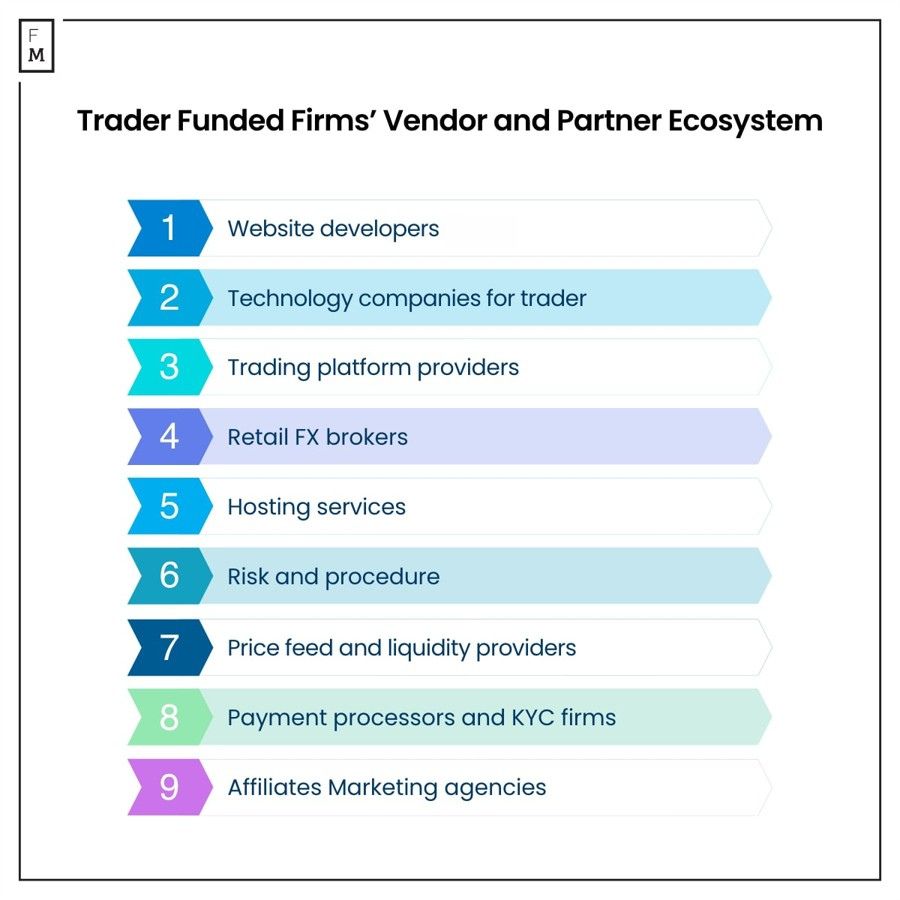The adoption and application of technology in Trader Funded Firms (TFFs) frequently sparks discussions, particularly due to the controversial ways in which some TFFs utilize it. And, when it comes to the technology stack of such TFFs, a multiple names, instead of a single service provider, can be involved.
It is a part of my ongoing series revealing the TFFs businesses. The first part distinguished prop trading firms from TFFs and the second looked into the jurisdictions where these companies are registered and their regulatory structure. This article provides an overview of the technological infrastructure within TFFs.

Key Components of Technologies Used by TFFs
The entire technology stack of a trading company can be massive. There can be multiple third-party service providers involved, some providing the trading interface, where other payment options. Similar to brokers, back office technologies play a big role for TFFs, both for traders and administrators. The key technology components of TFFs are:
- Payment-integrated website: essential for processing evaluation and subscription fees and other transactions.
- Trading interface: options include desktop, mobile, and web-based platforms, or a combination of these.
- Trader's back office/client portal: enables traders to manage payments, subscriptions, track account performance, and, optionally, view other traders' dashboards. There are some web-based trading platforms that come with a built- in Back Office.
- Administrative back office: a critical tool for company administrators to monitor trader activities, risk management, set challenge rules, and maintain separate or integrated web logins.
While the front end of a TFF is usually straightforward, the back end can be more complex, especially when multiple asset classes and trading platforms are involved. With a variety of over 30 trading platforms, each platform influences the back-end setup in its own way.
Trading Platform Dynamics
Trading platform providers often offer White Labels with a range of administrative rights or stand-alone options. Most providers skirt the need for a financial license but maintain basic KYC processes. It's important to note that the responsibility for the misuse of technology doesn't solely lie with platform providers. Some platforms are designed in ways that inadvertently encourage misuse.
For instance, in cases where a financial license is required for redistribution, many TFFs that lack such licenses find alternative access methods like Partnership with a Licensed Retail Broker or Vendor which grants them access to the platform.
Since TFFs primarily use demo accounts, platform providers often remain unaware of this usage. Monitoring every demo or API connection is impractical.
Many vendors have recognized this gap and are now offering TFF setups at a high cost, which theoretically incur minimal expense for them. Lately, this has fostered the increased collaboration between TFFs and retail brokers, with some brokers becoming particularly prominent in this sphere. I have identified 12 TFFs associated with the same retail broker.
It's also worth mentioning that some trading platforms can be distributed directly to the end-user for a nominal fee.
Vendor and Partner Ecosystem
The entire vendor and partner ecosystem of TFFs can be quite extensive. Although there are numerous consolidated service providers, when you delve deeper, you may uncover many different names. Some of the participants of these ecosystem are:
- Website developers and designers.
- Technology companies offering specialized trader interfaces (Client Portals designed for TFFs).
- Trading platform providers.
- Retail FX brokers.
- Hosting services (for standalone platforms).
- Risk and procedure consultants who aid in setting up trading rules and infrastructure.
- Price feed and liquidity providers, critical for operations and risk management.
- Payment processors and KYC firms, ensuring basic levels of regulatory compliance.
- Affiliates Marketing agencies or in-house set ups that help TFFs onboard new clients.
Challenges And Opportunities
Although the technical setup is generally straightforward, challenges persist in areas like customization, challenge rule management, and risk management. The sector is still awaiting innovations in Back Office development and AI integration, as most TFF setups show uniformity.
If you are interested to see a list of vendors for TFF with pricing, leave your email on the waiting list to receive a 50-page long business plan.
Disclosure: The views and opinions expressed in this article are solely those of the author and do not reflect the official policy or position of Advanced Markets.






















